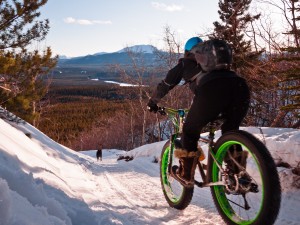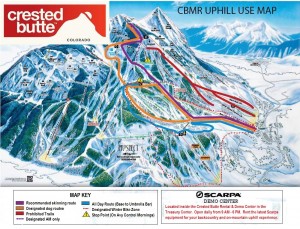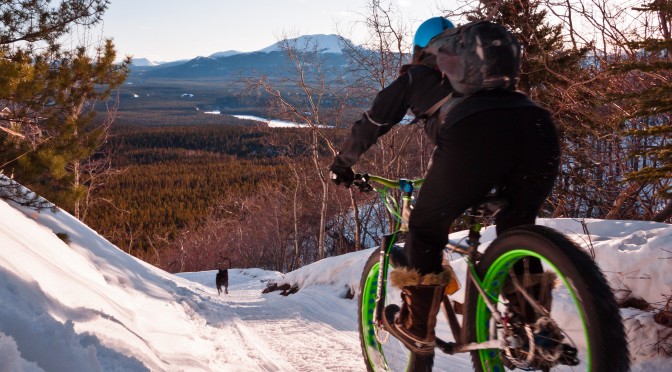Mt. Crested Butte, CO – The origins of mountain biking and their ties to Crested Butte, Colo., are well known by many, so it comes as no surprise that Crested Butte Mountain Resort (CBMR) has decided to welcome bikes during the winter months, too. With the rise in popularity of “fat bikes” within the biking industry, the resort realized the opportunity of allowing winter riding enthusiasts to enjoy the slopes with other uphill users.
Nearly three years ago, the resort launched an established uphill policy for skiers who were seeking to skin up the mountain before and after lift hours, due to the popularity of the sport at the time. The addition to include fat biking this year in the resort’s uphill policy was an apparent next step. In recognizing that winter biking is an ever-growing trend, the destination is also hosting the first ever Borealis Fat Bike World Championships, January 28 – 31, which includes a conference, demos and a race (solo or teams) in North Village, located just one mile from the ski resort in Mt. Crested Butte, a race at Town Park and downhill laps on the mountain’s summer mountain bike trails Awakening and Teaser.

Erica Mueller, Director of PR and Innovations, explains, “At CBMR, we try to fit the needs and desires of all user groups. With Crested Butte being a popular mountain bike destination in the summer, it makes sense for us to continue the trend in the winter by being one of the first areas to offer fat bikers access on the resort.”

The Winter Biking policy is similar to the resort’s Uphill Policy for skiers.
- Winter biking is only allowed before and after ski resort operating hours, which are 9 a.m. to 4 p.m.
- All bikers need to stop by the Adventure Center between 8 a.m. and 5 p.m. to review the biking policy, sign a waiver and receive a sticker for their pass.
- All uphill users are required to adhere to and obey all posted information and to be aware of trail closures and other operational considerations.
- Bike riders are allowed on all groomed terrain to the top of the Red Lady lift and the top of the Painter Boy lift. Bikers are not allowed on the upper mountain or to drop into Paradise Pod.






Bicycles should not be allowed in any natural area. They are inanimate objects and have no rights. There is also no right to mountain bike. That was settled in federal court in 1996. It’s dishonest of mountain bikers to say that they don’t have access to trails closed to bikes. They have EXACTLY the same access as everyone else — ON FOOT! Why isn’t that good enough for mountain bikers? They are all capable of walking….
A favorite myth of mountain bikers is that mountain biking is no more harmful to wildlife, people, and the environment than hiking, and that science supports that view. Of course, it’s not true. To settle the matter once and for all, I read all of the research they cited, and wrote a review of the research on mountain biking impacts. I found that of the seven studies they cited, (1) all were written by mountain bikers, and (2) in every case, the authors misinterpreted their own data, in order to come to the conclusion that they favored. They also studiously avoided mentioning another scientific study (Wisdom et al) which did not favor mountain biking, and came to the opposite conclusions.
Those were all experimental studies. Two other studies (by White et al and by Jeff Marion) used a survey design, which is inherently incapable of answering that question (comparing hiking with mountain biking). I only mention them because mountain bikers often cite them, but scientifically, they are worthless.
Mountain biking accelerates erosion, creates V-shaped ruts, kills small animals and plants on and next to the trail, drives wildlife and other trail users out of the area, and, worst of all, teaches kids that the rough treatment of nature is okay (it’s NOT!). What’s good about THAT?
In addition to all of this, it is extremely dangerous.
The common thread among those who want more recreation in our parks is total ignorance about and disinterest in the wildlife whose homes these parks are. Yes, if humans are the only beings that matter, it is simply a conflict among humans (but even then, allowing bikes on trails harms the MAJORITY of park users — hikers and equestrians — who can no longer safely and peacefully enjoy their parks).
The parks aren’t gymnasiums or racetracks or even human playgrounds. They are WILDLIFE HABITAT, which is precisely why they are attractive to humans. Activities, such as mountain biking, that destroy habitat, violate the charter of the parks.
Even kayaking and rafting, which give humans access to the entirety of a water body, prevent the wildlife that live there from making full use of their habitat, and should not be allowed. Of course those who think that only humans matter won’t understand what I am talking about — an indication of the sad state of our culture and educational system.